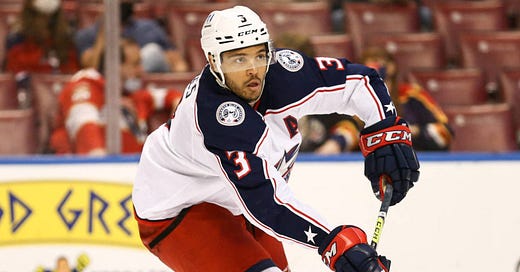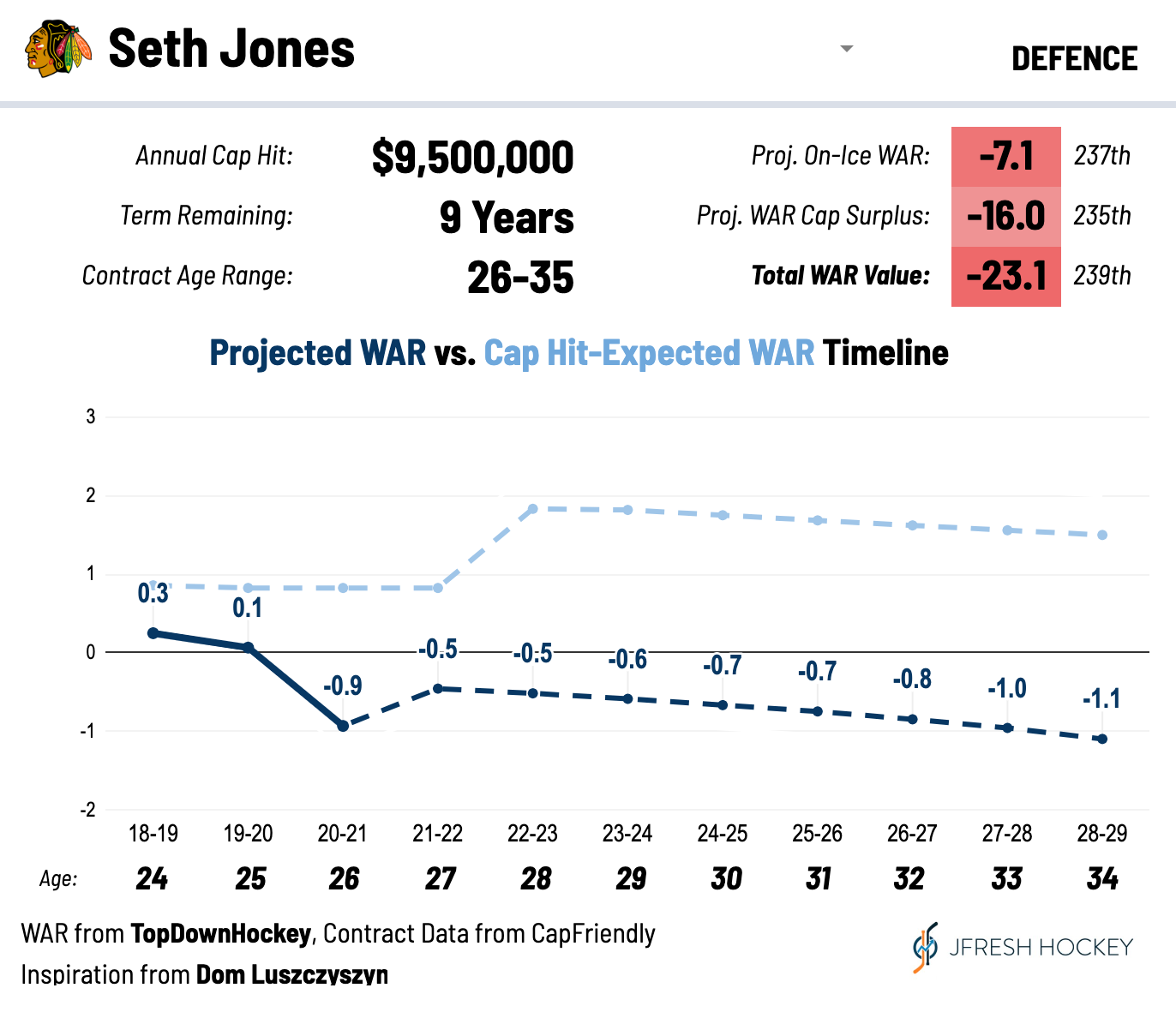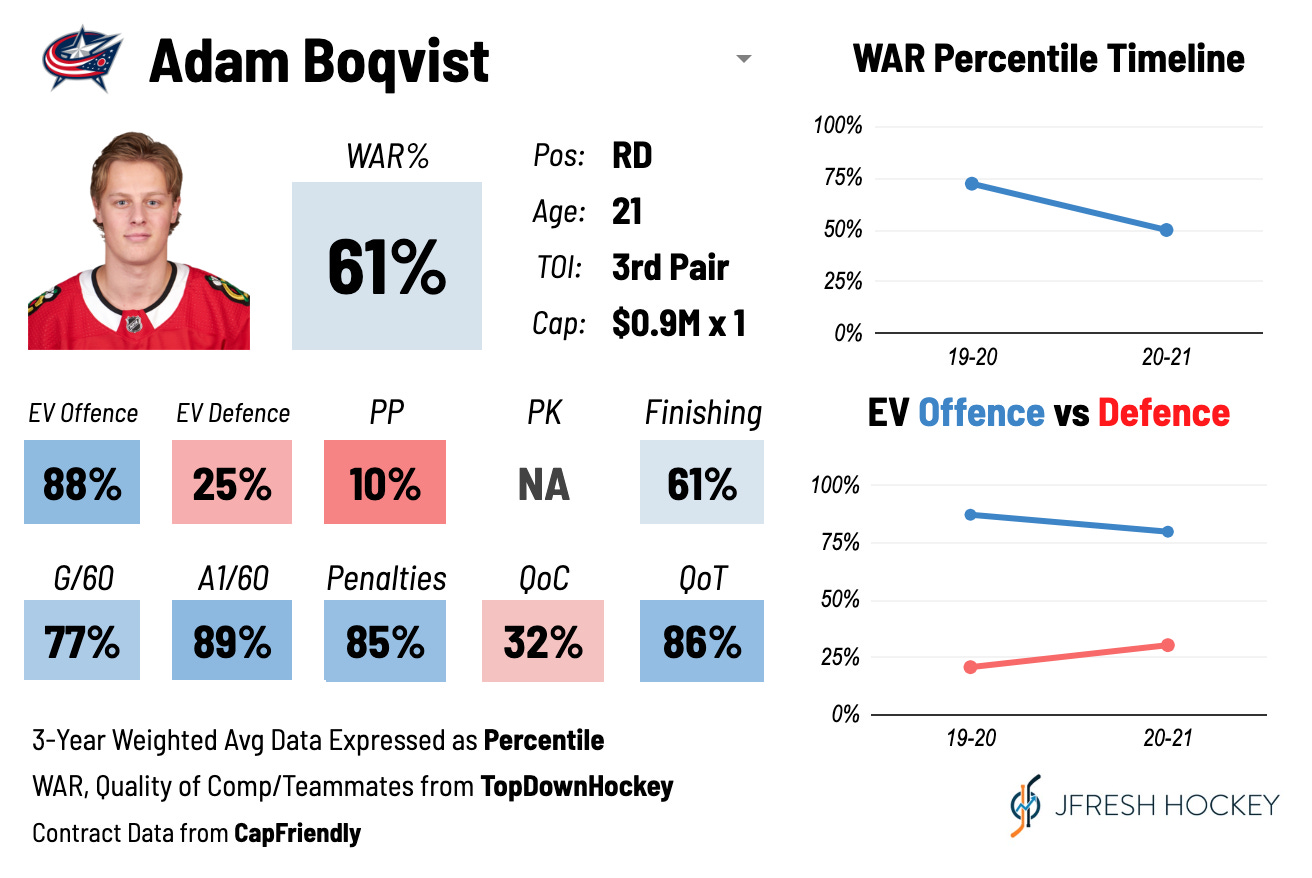Breaking Down the Seth Jones Trade and Extension Using Analytics
The Blackhawks went absolutely all in on a move that could backfire spectacularly.
Chicago receives: RD Seth Jones (extends him 8 years, $9.5M per year), 2021 32nd overall pick, 2022 6th round pick
Columbus receives: RD Adam Boqvist, 2021 12th overall pick, conditional 2022 1st round pick, 2021 44th overall pick
On a day of crazy trades for “minute munching” defencemen who aren’t exactly analytical darlings, this was the craziest. Seth Jones is the best player of the three big names moved (Rasmus Ristolainen and Oliver Ekman-Larsson have struggled for too long to be confident that they can return to form), but he also commanded by far the greatest price and got signed immediately to an unbelievable contract that will likely make him the 3rd-highest paid defenceman in the NHL when it kicks in.
I have written a lot about Jones in the past, including my lengthy breakdown of his game last offseason. I won’t just rewrite that entire piece, but I will get into some of the key points.
First let’s talk about the player himself.
Jones had a catastrophic season with Columbus this year. His 43.2% on-ice scoring chance share at 5v5 ranked near the bottom of the league and was the worst on his team by far. His isolated numbers crashed at both ends of the ice, accelerating a downward trend that had been going on for the past few seasons.
I’m willing to set aside this season because it represents such a dramatic drop-off for Jones’ results in an unusual season, and I don’t think it’s a fair representation of the kind of player he is. But as I detailed in my prior article, the player he was before that wasn’t particuarly exceptional either in terms of his ability to drive play at 5v5. For four consecutive seasons, Jones profiled as a defence-first #3/#4 guy, not the bona fide #1 that his reputation dictated.
So what drove these underwhelming results?
Brad Keffer of Broad Street Hockey did an excellent job in providing some examples of weaknesses in Jones' defensive game in his piece arguing that the Flyers shouldn't pay big assets to acquire him (written, I’m assuming, with a monkey’s paw). Credit to him for clipping the tape I’ll use here. Keffer and development coach Jack Han have identified the biggest issue in Jones’ game as defensive skating. Generally speaking, Jones’ skating is viewed as a strength because of his strong straight-line speed for a defenceman of his size. But it can be a big issue when he doesn’t have the puck, as his agility isn’t as good. Take defending entries against, for example. For the past several seasons, Jones has ranked well below-average in zone entry denials and forced dump-ins, allowing opponents to gain entry to the zone with possession between 66% and 75% of the time. While the trend around the league has been to play tougher gaps, Jones has lagged behind and tends to fall back and focus more on protecting the inside.
Here’s Hans’s input on this issue from a technical perspective:
[Jones'] inferior glide potential (due to having more of his weight on his heels rather than the front third of his skate blades) means that soon he will need to pivot from backward to forward skating in order to keep up with the puck carrier. As with crossovers, pivots temporarily puts a D-man in a vulnerable position where he cannot react to a forward’s change of direction.
Jones’ way of masking his inferior glide, then, is to play a looser gap across the neutral zone. This allows him to take an extra backward crossover to match speed or to pivot to forward skating while still protecting the middle of the ice. But this also destroys his ability to deny the blue line.
Jones’ strategy to keep opponents out of the slot has mixed results, as he can still get beat via the outside. His in-zone defence is adequate, but it’s primarily focused on pushing players along the boards and boxing out in front of the net (often through cross-checks which theoretically will be cracked down on next season). According to SportLogiq, he finished 29th in blocked passes per 60 minutes this season, a respectable if unremarkable rate, but in watching him last season I noticed the same thing that Keffer did, a lack of what he calls “possession-changing plays.” I specifically saw a lot of instances in which a stick check he made just put the puck in an area where his opponent could easily retrieve it.
In the offensive zone, the story on Jones is a lot of shots from the perimeter and point but very little in tight. This has bolstered his on-ice shot attempt numbers, which have always been much stronger than his on-ice scoring chance numbers, visible in this visualization from HockeyViz:
One of the flashiest elements of Jones’ game is his affection for carrying the puck into the offensive zone with possession. It was these rushes that brought him a lot of attention in the 2020 bubble playoffs, especially when everybody else on the ice was exhausted and he was still going end to end. The issue with these plays is that like many defencemen, once he gets into the zone he’s not particularly dangerous off the rush. According to Sznajder’s data while he’s fairly prolific at entering the zone off the rush, he’s a bit below-average at actually generating scoring chances once he crosses the line relative to his quantity. A downside of this is that it leaves his teammates vulnerable off the counter-attack, and when you’re leaving Zach Werenski to defend odd-man rushes you’re gonna have a bad time.
The Chicago system will encourage these aspects of Jones’ game, and I would expect to see even more rush play this season from him. And given the Hawks’ repeated weakness defensively (which was supposedly entirely to blame for Duncan Keith’s poor results), it’s difficult to envision a big improvement incoming for him in his own end.
Possibly the strongest argument supporting this case on Jones is an article by Mike Kelly of SportLogiq for Sportsnet which analyzes his game specifically using their private tracked data. As I mentioned in my article last summer, I think of Jones as the ultimate microstat-compiling defenceman in that he does such a high quantity of stuff but it doesn’t lead to overall results. So I was surprised to read in this piece that the microstats also reflect poorly on Jones: Kelly describes him as roughly average and “not a massive liability” defensively, and overall profiled him as good but deeply flawed and certainly not elite. He identifies areas where the Blackhawks might be a better fit stylistically (one of the strengths of that type of analysis) but my overall impression of the piece was “my God, if the microstats are down on Jones then something really has gone wrong.”
I would tend to agree with Kelly that I don’t think Seth Jones is one of the worst defencemen in the league and that his quality as a player lands somewhere between the current WAR projection and the elite reputation. But that’s bad news for the Blackhawks, who just paid him like a perennial Norris winner.
$9.5 million for Seth Jones is an unfathomable overpay. There’s simply no way around it, even setting aside analytics entirely. This is a 26-year old player who has never even been nominated for a Norris trophy; the only time in his career that he has even finished in the top 8 in Norris voting was 2017-18, a season in which he racked up points on a Panarin-run powerplay. He’s coming off an inarguably bad season, and he doesn’t even have a prolific postseason track record to point to (unless you count minutes played in one specific game). In a flat cap environment, these types of deals were supposed to be on the way out, especially with the Doughty and Karlsson deals setting a dangerous precedent. EvolvingHockey’s contract projection model, which is the best tool currently available to estimate a player’s market value and which has been very accurate in the past, estimates Jones at a five year $6.9M contract if he were a UFA today. At eight years, they project a $8M cap hit.
Bringing analytics back into the picture, by WAR this contract (combined with the final year of his current deal) projects to be the worst of any defenceman in the league. It’s worth mentioning that this is because it lasts for three more seasons than Karlsson’s or Doughty’s moving forward.
Even if we just threw out all objectivity and pretend that he wasn’t any worse this year than he was last year, it would still rank last.
As Jones exits his prime, which is a process that the numbers would argue began several years ago, his play is projected to decline, as we know that players generally do as they enter their 30s. And that’s bad news for the Blackhawks, who will be paying him to be the Norris-level defenceman that he has never been through most of the next decade.
So that’s Jones. Who did the Blackhawks give up?
Boqvist is a very productive offensive defenceman relative to his role, which has been pretty sheltered and limited so far in his young career. The former 9th overall pick still has a lot of holes in his game, especially defensively, but his upside is very interesting, especially if he can put it together on the powerplay.
Boqvist hasn’t quite established himself as a puck-mover on the breakout, and infrequently is the one passing the puck out of the defensive zone. More often, like Jones, he finds himself on the receiving end of those passes, as he loves to jump up and lead the rush. He entered the zone with control on 61% of his entries this season, the highest rate in the league (ahead of Roman Josi, Erik Karlsson, Matt Dumba, and Nick Leddy). Once in the zone he ranked 1st by far among Hawks defencemen in passes leading to a shot, suggesting strong playmaking upside.
Like most Blackhawks defencemen, Boqvist frequently got burned off the rush, and the Blue Jackets’ coaching staff will have to introduce a bit more structure to his game. But he has the upside of a top-end offensive defenceman.
Then there are the picks. The 12th overall pick in a draft is a valuable asset, and the Blue Jackets picked promising centre Cole Sillinger. The Hawks’ 1st round pick next year very well could be just as high if not higher, and the pick swap of 32 for 44 ultimately doesn’t amount to much historically speaking.
What all of this amounts to is what I would argue is a pretty inexplicable trade and a contract that could have huge consequences for this franchise moving forward. As a trade target, it would not have been difficult to imagine Jones reaching his past form and becoming a good contributor in a new organization, but this contract is essentially impossible for him to live up to and everything about it screams albatross. The question is just how quickly it becomes a capital-P Problem. Jones will munch hundred and hundreds of minutes for the Hawks, but as they learned once Keith started to decline after Cup #3, it’s not enough to just play big minutes, you have to excel in them. That’s a dot Jones hasn’t connected, especially in recent years, and it makes this whole endeavour a really troubling one for a Blackhawks team whose young core I was very excited about. Chicago needs Jones to be prime Duncan Keith for the better part of a decade, and while their bet might pay off it’s hard to be confident about it.











I think Jones is overrated. He is overpaid also. I like what Columbus got in return. Yes Jones is the best player in the trade right now but he isn’t worth the 9+ million annually. Werenski got a similar deal but I feel werenski is the better player. They are fairly close however. Both are overpaid. Unfortunately the rest of the Chicago defense is pretty bad. We will find out this year if Jones can survive on his own. Guess we can say the same about werenski. Guys like Jones, werenski, Hamilton will be needed more playing for younger teams.
Massive over pay for Jones, but I think he will do well in a new environment. Will be very hard to live up to that contract.